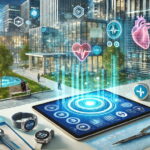The quick adoption of remote patient monitoring (RPM) accelerated the development of telehealth and played a vital role in making at-home care a reality. This novel approach to care delivery assisted in limiting the spread of COVID-19 among the most vulnerable populations by enabling healthcare professionals to offer patients acute and chronic illnesses with the entire spectrum of care.
The market worth of remote patient monitoring in 2021 was USD 1.45 billion, and it will reach USD 4.07 billion by 2030, growing at an 8.74% CAGR during the forecast period.
By implementing RPM into a patient’s care plan, physicians can monitor vitals and health data between visits, allowing them to respond quickly and make treatment modifications before a patient’s condition deteriorates or necessitates an expensive trip to the emergency department (ED). With this vital health data, clinicians may make more informed clinical decisions and provide more efficient and effective care.
Remote Patient Monitoring: Old Vs. AI-enabled Method
The idea of remote patient monitoring (RPM) is familiar and has existed for a while. However, the pandemic has influenced the installation of new systems in hospitals.
On the other hand, traditional RPM involves positioning a camera to stream the video across a network to send to a display in a different location for manual monitoring. Although it can help with patient monitoring, employees must be accessible to view the display at all times. These devices also lack analytical capabilities based on the data captured on the stream.
AI has the potential to drastically alter this situation. It is now possible to automate gathering data for various types of predictive ML (machine learning) based models for inferencing due to the use of AI in remote patient monitoring.
Role of AI & Camera in Enhancing the Potential of RPM Devices
To effectively employ AI in remote patient monitoring scenarios, embedded vision, and camera technology needed to be included. Innovative embedded cameras have made it possible to collect high-quality images regardless of the lighting in the patient’s room, from high-resolution cameras to NIR cameras and RGB-IR cameras.
One or more acceptable digital imaging solutions that can be incorporated into hospital networks are required for remote patient monitoring. It enables healthcare teams to assess patient conditions from a distance and health professionals to monitor several patients.
Remote patient monitoring is progressing by utilizing artificial intelligence, from simple monitoring to performing behavioral analysis such as fall detection, tracking patient movements, monitoring people in a room, and much more.
To avoid further falls, the patient’s behavior is analyzed and categorized according to frameworks like PeopleNet.
Role of AI-enabled RPM in Improving Care Delivery
AI and RPM can promote therapeutic effectiveness, improve outcomes, and increase patient adherence. The four ways AI-enabled RPM improves care delivery are as follows:
Increases patient adherence and self-management
Patient adherence is one of the issues preventing the widespread implementation of RPM. Many patients need more support and incentive to use RPM effectively, and most clinics need more time to monitor patients’ compliance. With AI-enabled RPM, a virtual health assistant communicates with patients via text message to remind them to take their readings and to offer support and instruction. Patient retention rises as a result of increased patient adherence.
Boost Clinical efficiency
Higher patient compliance results in more frequent readings, which provides the practitioner with more precise and useful data. With this knowledge, physicians can make planned care decisions and better tailor treatment to meet their patients’ requirements. A practice may go months without engaging with a patient if there is no ongoing communication between the patient and the provider.
Fosters better patient outcomes
Patients suffering from chronic conditions such as hypertension, heart failure, diabetes, and obesity frequently require strict adherence to medicine, exercise, and care programs daily. Providers can spot health trends across time and between visits using AI-enabled RPM, which leads to early interventions, fewer hospitalizations, and better patient outcomes. AI-enabled RPM has been shown to enhance patient health measures, including significant decreases in blood pressure, blood glucose, and weight.
Lower care costs
AI-enabled RPM technology may minimize avoidable ED visits and inpatient utilization, ultimately lowering care costs by enabling early diagnosis of clinical deterioration and more timely therapy.
Remote Patient Monitoring Insurance
Remote patient monitoring insurance coverage is increasingly essential as more healthcare providers adopt AI-driven RPM tools. Many insurance plans now offer partial or full coverage for RPM services, recognizing its role in reducing emergency visits and hospitalizations. By covering RPM costs, insurers support preventive care, which helps manage chronic conditions effectively and reduces overall healthcare expenditures. Expanding RPM insurance options can further accelerate its adoption, making it accessible to more patients, especially those in rural or underserved areas.
Future of Ai-Based Remote Patient Monitoring
Embedded vision is one of the technologies destined to play a significant role in AI-powered remote patient monitoring. Modern embedded vision cameras allow for recording high-quality imagery independent of the lighting in a patient’s room. This not only enables remote monitoring but also allows health staff to monitor several patients at the same time.
These cameras, when combined with AI, can deliver highly specific behavioral analysis Staff can monitor patient movements to spot any strange behaviors or unexpected falls. While this saves time and enhances capabilities, implementing this technology is still some time away.
References:
Global remote patient monitoring devices market (2021 – 2030)
Read Also
- Optimizing CT Protocols: The Hidden Key to Efficiency and Cost Savings in RadiologyIntroduction: Why CT Protocol Optimization Matters Computed Tomography (CT) is a cornerstone of modern diagnostic imaging, providing critical information across nearly every medical specialty. However, maximizing the value of CT — both clinically and financially — requires more than just advanced hardware. The real secret lies in the optimization of CT protocols. When CT protocols… Read more: Optimizing CT Protocols: The Hidden Key to Efficiency and Cost Savings in Radiology
- The Role of Carbide Burs in Modern Dental ProceduresAs a result of this procedures need to be well coordinated and to this end, precision tools are used by dental practitioners. Among the most essential tools in a dentist’s arsenal are carbide burs, which have revolutionized various aspects of dental work. Today’s dentistry cannot work without these tools as they are both strong, sharp,… Read more: The Role of Carbide Burs in Modern Dental Procedures
- Detection of Diabetic Retinopathy: The AI AdvantageDiabetic retinopathy (DR) is a leading cause of blindness among working-age adults, affecting millions worldwide. The prevalence of DR is alarmingly high, affecting an estimated 34.6 million people globally. In the United States alone, it is estimated that 7.7 million adults have some form of diabetic retinopathy. How Does Diabetes Affect the Eye? Most of… Read more: Detection of Diabetic Retinopathy: The AI Advantage
- Advances in Digital Health: Transforming Modern HealthcareThe healthcare landscape is undergoing a seismic shift with the advent of digital health technologies. These innovations are not just modern conveniences; they are transformative tools that bridge gaps in accessibility, improve patient outcomes, and empower individuals to take charge of their health. From wearable devices to telehealth and artificial intelligence, digital health is creating… Read more: Advances in Digital Health: Transforming Modern Healthcare
- The Latest Advancements in Urology ProceduresUrology, the branch of medicine concerning the urinary system and male reproductive organs, has seen remarkable advancements in recent years. Technological innovations have led to more precise, less invasive, and increasingly successful procedures that promise better outcomes for patients. From state-of-the-art robotics to personalized medicine approaches, the field of urology is evolving at a rapid… Read more: The Latest Advancements in Urology Procedures






